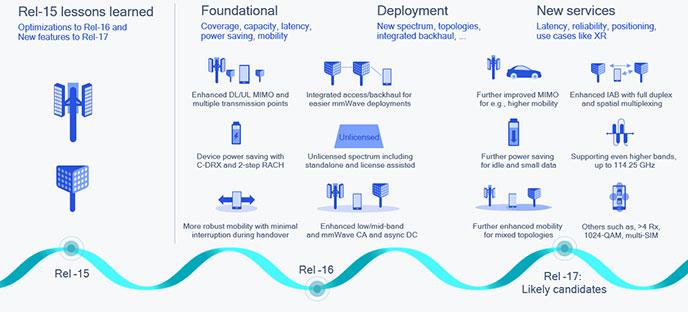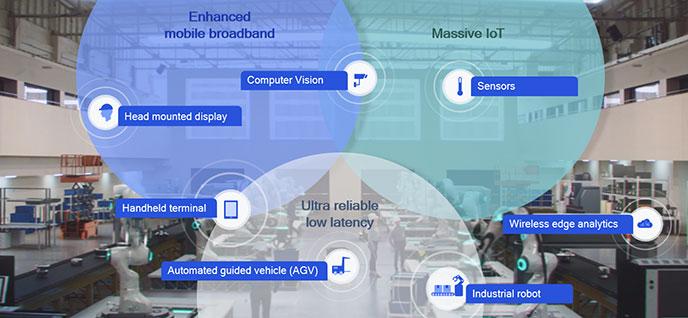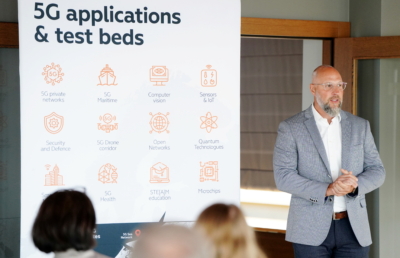- Improving mobility is one of the core research areas for multi-radio access systems with enhancements for minimizing interruptions during a handover, allowing for quicker activation of carrier aggregation, and supporting more seamless dual connectivity.
- By leveraging 5G NR URLLC to support time-sensitive networking (TSN), 5G can meet the most stringent IIoT use case requirements, achieving reliability up to 99.9999% with an end-to-end latency as low as a millisecond.
- There’s an extensive interest from broadcasters and mobile operators in deploying enTV for terrestrial digital TV delivery in both Europe and China.

In this blog post, I will highlight several key 5G R&D initiatives that are underway to help to deliver that 5G progress.
The work to further enhance the 5G NR Release 15 technology foundation has already begun, and this will not only bring even better mobile broadband efficiencies and experiences, but also extend the overall reach of 5G to new devices, services, and industries.
Today, we are focusing our end-to-end system standardization efforts on 3GPP Release 16 items, which are slated for completion in early 2020, and we are also actively working with the mobile and vertical ecosystems on the definition of Release 17, with its scope to be decided at the December 2019 Plenary meetings.

Continued 5G NR evolution to deliver on the 5G vision.
Below is a short summary of some of our ongoing wireless system R&D focus areas to give you a better idea of the span of the items we are working on and how they fit together to enhance and expand the 5G boundaries.
Foundational enhancements for future mobile broadband and more
While Release 15 established a solid technology foundation for 5G NR in both sub-7 GHz and mmWave, we continue to work on multiple fronts to further improve its performance and efficiency, including better coverage, capacity, latency, mobility, power, and more. These enhancements will benefit not only core mobile broadband services and smartphone connectivity, but also the expanded use cases that 5G NR is bringing with Release 16 and beyond.
One key area of foundational research is continued advancements to multiple antenna MIMO technology. We are working on enhancements that can deliver more optimized downlink and uplink massive MIMO operations, reduced signaling overhead, lower latency, and expanded support for multiple transmission points. For both sub-7 GHz and mmWave, this work involves complex end-to-end testbed experimentation including RF designs, as well as proving out the systems algorithm implementations on the network and device side.
In addition, we are also focusing on further reduction of device power consumption with features like enhanced C-DRX (connected mode discontinuous reception) and 2-step RACH (simplified random-access procedure).
Improving mobility is another core research area for multi-radio access systems with enhancements for minimizing interruptions during a handover, allowing for quicker activation of carrier aggregation, and supporting more seamless dual connectivity. These and other foundational mobile broadband enhancements across time are shown here:

5G NR foundational enhancements for eMBB in Rel-16 and beyond.
Ultra-reliability and low-latency for high performance Industrial IoT (IIoT)
One of the key goals in 5G was to expand cellular to new vertical markets and use cases, and 5G IIoT is one area that is generating a lot of interest from both the mobile and industrial ecosystems. There is an opportunity for 5G to become the de-facto connectivity solution for “Industry 4.0”, providing a scalable solution that can efficiently address the wide range of IIoT device and service requirements.
We are also expanding support for private 5G networks in Release 16, which can utilize different types of spectrum – licensed, shared, and unlicensed. In our 5G IIoT and shared spectrum R&D testbeds, we are experimenting with new spatial approaches that could provide higher capacity and reliability.
One key use case for a private 5G network is IIoT: by leveraging 5G NR URLLC to support time-sensitive networking (TSN), 5G can meet the most stringent IIoT use case requirements, achieving reliability up to 99.9999% with an end-to-end latency as low as a millisecond.
What will this do?
This will allow 5G to replace today’s wired industrial ethernet to make factories more flexible and reconfigurable. In addition, we are also working on new features such as precise positioning, which is an important requirement l for many IIoT use cases such as ground robots and asset tracking.

5G NR is being designed to support a wide range of IIoT use cases.
Leveraging Cellular-V2X for smarter transportation
Our vision for the future of smarter transportation builds on a variety of R&D investigations focused on making our roads safer, our cars more autonomous, and our in-vehicle experiences more enjoyable. A core enabling technology of our 5G automotive vision is Cellular-Vehicle-to-Everything (C-V2X), which allows cars to communicate, even in non-line-of-slight (NLOS) situations, to other cars (V2V), road infrastructure (V2I), pedestrians (V2P), and networks (V2N).
From a standardization standpoint, with the solid C-V2X foundation in 3GPP Releases 14 and 15, we are now working on 5G NR-based C-V2X in Release 16 with a focus on supporting advanced automotive use cases to help make driving safer, travel faster, and energy consumption more efficient.
The advancements of C-V2X gives cars the ability to share their sensor data with one another, making it possible for cars to avoid collisions in more situations. Better situational awareness and intention sharing can allow drivers and cars to coordinate their trips more efficiently, thereby leading to traffic avoidance for faster travel and lower energy consumption.

5G connectivity fabric for smarter transportation of tomorrow.
Other expansion areas: massive IoT, broadcast, XR, and more
To meet the 5G vision of connecting virtually everything around us, we also need to scale 5G to the other extreme of massive IoT — to connect low-complexity devices that require extended coverage and long battery life.
The 5G massive IoT solution for low-power wide area (LPWA) connectivity is based on the eMTC/NB-IoT technology evolution that started in 3GPP Release 13. Release 16 will bring these technologies into the 5G NR framework, supported by the new 5G core network with optimized in-band 5G NR deployment.
5G massive IoT will continue to evolve in future 3GPP releases to bring even better capabilities and efficiencies, with features such as asynchronous grant-less uplink and multi-hop mesh networking. We are engaged in R&D targeting Release 17 and beyond, with a focus on extending 5G NR massive connectivity to a variety of data rate scenarios and device types.
Similarly, the new enTV design in Release 14 is the basis for 5G broadcast and it is being enhanced in Release 16 to fully meet 5G broadcast requirements, such as supporting longer inter-cell distance and higher mobility. On the commercial front, we are seeing extensive interest from broadcasters and mobile operators in deploying enTV for terrestrial digital TV delivery in both Europe and China.
To pave the way for next-generation XR (extended reality) experiences, we are defining how virtual and augmented reality (VR/AR) experiences can be taken to the next level with 5G — we call this boundless XR. With 5G enabling high-speed and low-latency links between XR devices and the edge cloud, we can use these edge servers to augment on-device processing and bring low-latency photorealistic graphics and visuals in a more power efficient way.
Today, we are working closely with ecosystem leaders to optimize the 5G system design for XR traffic, and we expect this to become a part of the upcoming 5G NR releases.
Learn more
This blog post is by no means meant to be an exhaustive list of all things 5G will deliver, as many new ideas and research areas are still being defined that may soon enable new use cases that we haven’t even thought of yet.
To learn more about the work we are doing to deliver on the promise of 5G, watch this Fierce Wireless webinar and visit our 5G technology webpage. And to stay up to date, don’t forget to sign up to our wireless technologies newsletter as we accelerate into our 5G future.


